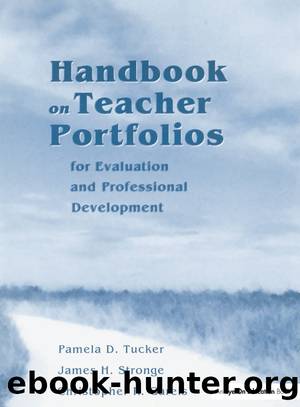Handbook on Teacher Portfolios for Evaluation and Professional Development by Tucker Pamela;Stronge James;Gareis Christopher;

Author:Tucker, Pamela;Stronge, James;Gareis, Christopher;
Language: eng
Format: epub
Publisher: Taylor & Francis Group
Published: 2002-08-15T00:00:00+00:00
What Are Guidelines for Developing and Using Portfolios in Teacher Evaluation?
In Chapter 3, we shared some practical steps for implementing teacher portfolios in a school or district setting. Drawn from the literature on teacher evaluation and portfolios assessment, here we offer additional tips that can be useful in planning and implementing a performance evaluation system that incorporates teacher portfolios as an important component in a quality teacher evaluation system. Although these guidelines echo the steps outlined in Chapter 3, they specifically address the inclusion of portfolios for distinguishing the variations in quality of teacher performance.
â Communication is critically important in teacher evaluation. Grant Wiggins17 in writing about the use of portfolio assessment with students, made a point that is germane to our discussion of the use of portfolios with teachers: procedures must be developed through a collaborative, public forum in which the audience and client are involved. Throughout the teacher evaluation process, including the development of procedures for use of portfolios, teachers have every right to be involved in, and to know about, the evaluation system as much as possible. Additionally, the portfolio can serve as a vehicle for enhancing conversations regarding performance throughout the evaluation process.
â Relate the overall teacher evaluation system and individual performance roles to goals of the organization. Designing a teacher evaluation system that relies on authentic data, such as portfolios, must begin by matching the goals of the school or school system with the needs of students, teachers, administrators, parents, and the larger community. In fact, determining the needs of the organization is a prerequisite for all remaining steps if the evaluation process is to be relevant to the organizationâs mission and, ultimately, responsive to the public demands for accountability.
â The context of teacher evaluation must be taken into account. Understanding and accounting for the context of teacher evaluation is another critical factor in developing sound evaluation systems.18 A few suggestions in this regard include:
⢠Data collection should be context-specific and based on real job performance.
⢠Authentic assessment, such as in performance portfolios, should be composed of real instances of criterion-based, extended performances.19
⢠Authentic assessment with teacher portfolios involves frequent, brief evaluations of work that evolve from, and are tied to, curricular objectives and content.20
⢠The teacherâs evaluation should not be a one-shot formal classroom observation, but rather an ongoing, systematic data collection, formal and informal, over time.
â Base the teacher evaluation on clearly defined job duties. In general, performance evaluation needs to be built upon clear and reasonable duties of the teacher.21 In other words, evaluate the teacher on what she or he was hired to do. The detailed âPerformance Standardsâ in Appendix A can be used to clarify the job expectations of the teacher. Additionally, the teacher performance standards become the framework for organizing the portfolio and presenting evidence of performance.
â A performance assessment rubric must be used to make fair judgments in teacher evaluation. Setting standards involves determining appropriate levels of performance, such as meeting expectations, exceeding expectations, or needing improvement. Procedures
Download
This site does not store any files on its server. We only index and link to content provided by other sites. Please contact the content providers to delete copyright contents if any and email us, we'll remove relevant links or contents immediately.
Chicken Soup for the Soul Presents Teens Talkin' Faith by Jack Canfield(655)
Understanding PDA Autism in Kids: A Guide for Parents and Teachers to Support Neurodiverse Learners by Jehu Len(555)
The Victorian Era: A Captivating Guide to the Life of Queen Victoria and an Era in the History of the United Kingdom Known for Its Hierarchy-Based Social Order by Captivating History(424)
Brain Teasers to Build Critical Thinking Skills by Safarova Kris(411)
Brain Teasers to Build Critical Thinking Skills: Brain Exercises for Tech, Banking, Case Interview Prep, and to Keep Your Mind Sharp by Kris Safarova(411)
100 Ideas for Secondary Teachers: Engaging Parents by Janet Goodall & Kathryn Weston(388)
Python 101 - Fundamentals by Sam(373)
Critical Curriculum Leadership : A Framework for Progressive Education by Rose M. Ylimaki(363)
Writing Solid Code: Development Philosophies for Writing Bug-Free Programs by Steve Maguire(357)
The Art of Emotional Validation: Improve Your Communication Skills and Transform Your Relationships by Validating Emotions and Feelings by Emily Wright(339)
Intersectionality in Educational Research by Dannielle Joy Davis; James L. Olive; Rachelle J. Brunn-Bevel; Susan R. Jones(331)
The Knights Templar: An Enthralling History of the Rise and Fall of the Most Influential Catholic Military Order by Wellman Billy(330)
A Beginner's Guide to SSD Firmware by Unknown(327)
The Future Knowledge Compendium by Ellyard Peter;(319)
How to be assertive in any situation by Hadfield Sue & Hasson Gill(310)
Making Connections in and Through Arts-Based Educational Research by Hala Mreiwed Mindy R. Carter Sara Hashem Candace H. Blake-Amarante(306)
Foundations of Educational Research by Victoria Elliott(305)
What Every Teacher Should Know about Learning, Memory, and the Brain by Tileston Donna E. Walker;(305)
Message from the Pleiades; The Contact Notes of Eduard Billy Meier v1 only by unknow(301)
